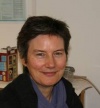Difference between revisions of "MAGICC team"
(Created page with "==Background== MAGICC has a history of over 20 years and was brought to life by Tom Wigley and Sarah Raper, largely during their time at the Climate Research Unit at the Univ...") |
|||
| Line 1: | Line 1: | ||
==Background== | ==Background== | ||
| − | MAGICC has a history of over 20 years and was brought to life by Tom Wigley and Sarah Raper, largely during their time at the Climate Research Unit at the University of Norwich. A lot of recent development has as well taken place by Tom Wigley at the National Centre for Atmospheric Research in Boulder, USA. Malte Meinshausen joined and co-developed the most recent MAGICC version. Furthermore, numerous collaborators and users help to expand the code, report bugs and thereby provide an invaluable contribution to the ongoing development of MAGICC. Particular thanks go as well to the international model intercomparison efforts of various kinds, which provide the vital database for parameterizing and calibrating various climate change, gas cycle and carbon cycle uncertainties. Without those, the MAGICC model, or any other reduced-complexity modelling approach, would miss the data for calibration and therefore its basis to estimate future climate change and its uncertainties. | + | MAGICC has a history of over 20 years and was brought to life by Tom Wigley and Sarah Raper, largely during their time at the Climate Research Unit at the University of Norwich. A lot of recent development has as well taken place by Tom Wigley at the National Centre for Atmospheric Research in Boulder, USA. Malte Meinshausen joined and co-developed the most recent MAGICC version. Furthermore, numerous collaborators and users help to expand the code, report bugs and thereby provide an invaluable contribution to the ongoing development of MAGICC. Particular thanks go as well to the international model intercomparison efforts of various kinds, which provide the vital database for parameterizing and calibrating various climate change, gas cycle and carbon cycle uncertainties. Without those, the MAGICC model, or any other reduced-complexity modelling approach, would miss the data for calibration and therefore its basis to estimate future climate change and its uncertainties. |
== The MAGICC Developers == | == The MAGICC Developers == | ||
| − | [[File:Tom_Wigley_small.jpg|100px|thumb|right|Dr. Tom Wigley]] Dr. Tom Wigley - is senior scientist in the Climate and Global Dynamics Division at NCAR in Boulder, USA and has been named a fellow of the American Association for the Advancement of Science (AAAS) for his major contributions to climate and carbon-cycle modeling and to climate data analysis. He is now part time again at the University of Adelaide, Australia, where he received his doctorate as a mathematical physicist. Tom is one of the world's foremost experts on climate change and one of the most highly cited scientists in the discipline. | + | [[File:Tom_Wigley_small.jpg|100px|thumb|right|Dr. Tom Wigley]] Dr. Tom Wigley - is senior scientist in the Climate and Global Dynamics Division at [http://www.cgd.ucar.edu/cas/ NCAR ] in Boulder, USA and has been named a fellow of the American Association for the Advancement of Science (AAAS) for his major contributions to climate and carbon-cycle modeling and to climate data analysis. He is now part time again at the University of Adelaide, Australia, where he received his doctorate as a mathematical physicist. Tom is one of the world's foremost experts on climate change and one of the most highly cited scientists in the discipline. |
| − | [[File:Sarah_Raper_small.jpg|100px|thumb|right|Dr. Sarah Raper]] Dr. Sarah Raper - is Senior Research Fellow at the Centre for Air Transport and the Environment at Manchester Metropolitan University. Sarah is a climate modeller, specializing in mountain glaciers, sea level rise, emulation of AOGCM climate models and, of course, the co-development of MAGICC. Sarah has an extensive involvement in the Intergovernmental Panel on Climate Change (IPCC), having been a lead author of the projections chapter of the IPCC 3rd and 4th Assessment Reports. | + | [[File:Sarah_Raper_small.jpg|100px|thumb|right|Dr. Sarah Raper]] Dr. Sarah Raper - is Senior Research Fellow at the [http://www.cate.mmu.ac.uk/ Centre for Air Transport and the Environment at Manchester Metropolitan University]. Sarah is a climate modeller, specializing in mountain glaciers, sea level rise, emulation of AOGCM climate models and, of course, the co-development of MAGICC. Sarah has an extensive involvement in the Intergovernmental Panel on Climate Change (IPCC), having been a lead author of the projections chapter of the IPCC 3rd and 4th Assessment Reports. [http://www.cate.mmu.ac.uk/staffpage.asp?chg2=staff&chg=who&id=197 Sarah's home page]. |
| − | [[File:Malte_Meinshausen_small.jpg|100px|thumb|right|Dr. Malte Meinshausen]] Dr. Malte Meinshausen - is Honorary Senior Research Fellow at the School of Earth Sciences, University of Melbourne and Senior Researcher at the Potsdam Institiute for Climate Impact Research, Germany. Earlier he was a Post-Doc at the National Center for Atmospheric Research in Boulder, Colorado. He has been contributing author to various chapters in the Fourth Assessment Report of the Intergovernmental Panel on Climate Change (IPCC AR4). | + | [[File:Malte_Meinshausen_small.jpg|100px|thumb|right|Dr. Malte Meinshausen]] Dr. Malte Meinshausen - is Honorary Senior Research Fellow at the School of Earth Sciences, University of Melbourne and Senior Researcher at the Potsdam Institiute for Climate Impact Research, Germany. Earlier he was a Post-Doc at the National Center for Atmospheric Research in Boulder, Colorado. He has been contributing author to various chapters in the Fourth Assessment Report of the Intergovernmental Panel on Climate Change (IPCC AR4). [http://www.pik-potsdam.de/members/mmalte Malte's home page]. |
== Acknowledgements and key contributors == | == Acknowledgements and key contributors == | ||
| Line 17: | Line 17: | ||
== The web-interface to MAGICC6 on live.magicc.org == | == The web-interface to MAGICC6 on live.magicc.org == | ||
| − | As a recent development, MAGICC6 was equipped with a web-interface, accessible via live.magicc.org. The programmer behind this effort is Antonius Golly, member of the PIK Research Group PRIMAP. | + | As a recent development, MAGICC6 was equipped with a web-interface, accessible via [http://live.magicc.org live.magicc.org]. The programmer behind this effort is Antonius Golly, member of the PIK Research Group [http://www.primap.org PRIMAP]. |
Revision as of 11:19, 17 June 2013
Contents
Background
MAGICC has a history of over 20 years and was brought to life by Tom Wigley and Sarah Raper, largely during their time at the Climate Research Unit at the University of Norwich. A lot of recent development has as well taken place by Tom Wigley at the National Centre for Atmospheric Research in Boulder, USA. Malte Meinshausen joined and co-developed the most recent MAGICC version. Furthermore, numerous collaborators and users help to expand the code, report bugs and thereby provide an invaluable contribution to the ongoing development of MAGICC. Particular thanks go as well to the international model intercomparison efforts of various kinds, which provide the vital database for parameterizing and calibrating various climate change, gas cycle and carbon cycle uncertainties. Without those, the MAGICC model, or any other reduced-complexity modelling approach, would miss the data for calibration and therefore its basis to estimate future climate change and its uncertainties.
The MAGICC Developers
Dr. Tom Wigley - is senior scientist in the Climate and Global Dynamics Division at NCAR in Boulder, USA and has been named a fellow of the American Association for the Advancement of Science (AAAS) for his major contributions to climate and carbon-cycle modeling and to climate data analysis. He is now part time again at the University of Adelaide, Australia, where he received his doctorate as a mathematical physicist. Tom is one of the world's foremost experts on climate change and one of the most highly cited scientists in the discipline.
Acknowledgements and key contributors
Many people helped in various ways in the development of MAGICC over the past 20 years, namely M. Salmon, M. Schlesinger, M. Hulme, T. Osborn, S. McGinnis and many more. We would like to warmly thank all those contributors and collaborators for making MAGICC possible. A special thanks to Dan Sandiford for making this WIKI possible.
The web-interface to MAGICC6 on live.magicc.org
As a recent development, MAGICC6 was equipped with a web-interface, accessible via live.magicc.org. The programmer behind this effort is Antonius Golly, member of the PIK Research Group PRIMAP.


